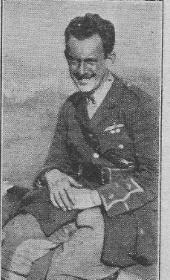Captain Gilbert Ware Murlis Green
Highly decorated Officer
Captain Gilbert W. Murlis Green was the son of Mr & Mrs J. W. Murlis Green, born in London on the 24th January 1895. His family were from Beckenham.
Gilbert joined the army in 1914 and transferred to the Royal Flying Corps the following year.
He was a Royal Air Force career officer credited with eight aerial victories and was highly decorated for this.
He was awarded the Distinguished Service Order and Serbian Order of Karageorge for duties effectively accomplished and for deed such as bringing down 3 enemy German planes within two days on the Doiran front. He had already shot down 4 enemy machines single-handed and another one in which he shared the honours with a brother airman.
On another occasion he engaged an Albatros so that it dived out of control and its pilot was seen to fall from it
In January 1917, aged 22, he was awarded the Military Cross for conspicuous gallantry in action. Pouring in a drum of ammunition into an enemy trench, killing or badly wounding 87 men. He gained a Bar for bringing down two enemy ‘hun’ planes on successive days under adverse circumstances. He had displayed great dash and courage at every opportunity.
In February, 1917, he brought down 2 gothas and an ‘Albatross.’ In December, 1917 downed another Gotha for which he gained a Bar to his M.C.

Descriptions of his exploits were amazing:
‘In February, 1917, an orderly came into our young friend’s tent and said, “The travelling circus is coming over, sir,” and overhead in the distance were to be seen a squadron of Gothas en route for Salonica with the probable intention of bombing that town.
‘“All right, get my single-seater ready,” As soon as the squadron of Gothas had passed south of his aerodrome, up went our youth and climbed till he was about 1,000 feet above his intended prey.
‘He then made a nose-dive towards them, passed under some of them and came up in the midst of their formation, where they dared not fire at him for fear of hitting each other. He then manoeuvred so as to get immediately underneath one of their machines and after steadying himself, operated his machine gun. Firing first along the fuselage and then forward, he split the petrol tanks and killed the pilot. The result of this was a drenching bath of petrol for himself which necessitated his turning off his own spark for fear of catching fire.
‘The overhead machine then began to descend upon him, and in order to avoid this danger, he turned his own ‘Scout’ completely on its side, and ‘side-slipped’ nearly to the earth. Flattening out just in time, he made a bumpy landing, damaging his under-carriage and shaking himself considerably.
‘Climbing out and seeing the other Hun machines waiting for him, he hated to disappoint them, so climbing into another machine, he went up again at once and fetched another down in almost identical manner. The whole proceedings took about one hour, and before 24 hours had elapsed, he had brought down a huge “Albatross.”
Sources:
Bromley & District Times, 6th April 1917 (page 5)
Bromley & District Times, 4th January 1918 (page 5)
Bromley & District Times, 11th January 1918 (page 5)
London Gazette (supplement), 13th February 1917 (29940/1539)
Military Wiki – Gilbert W.M. Green
